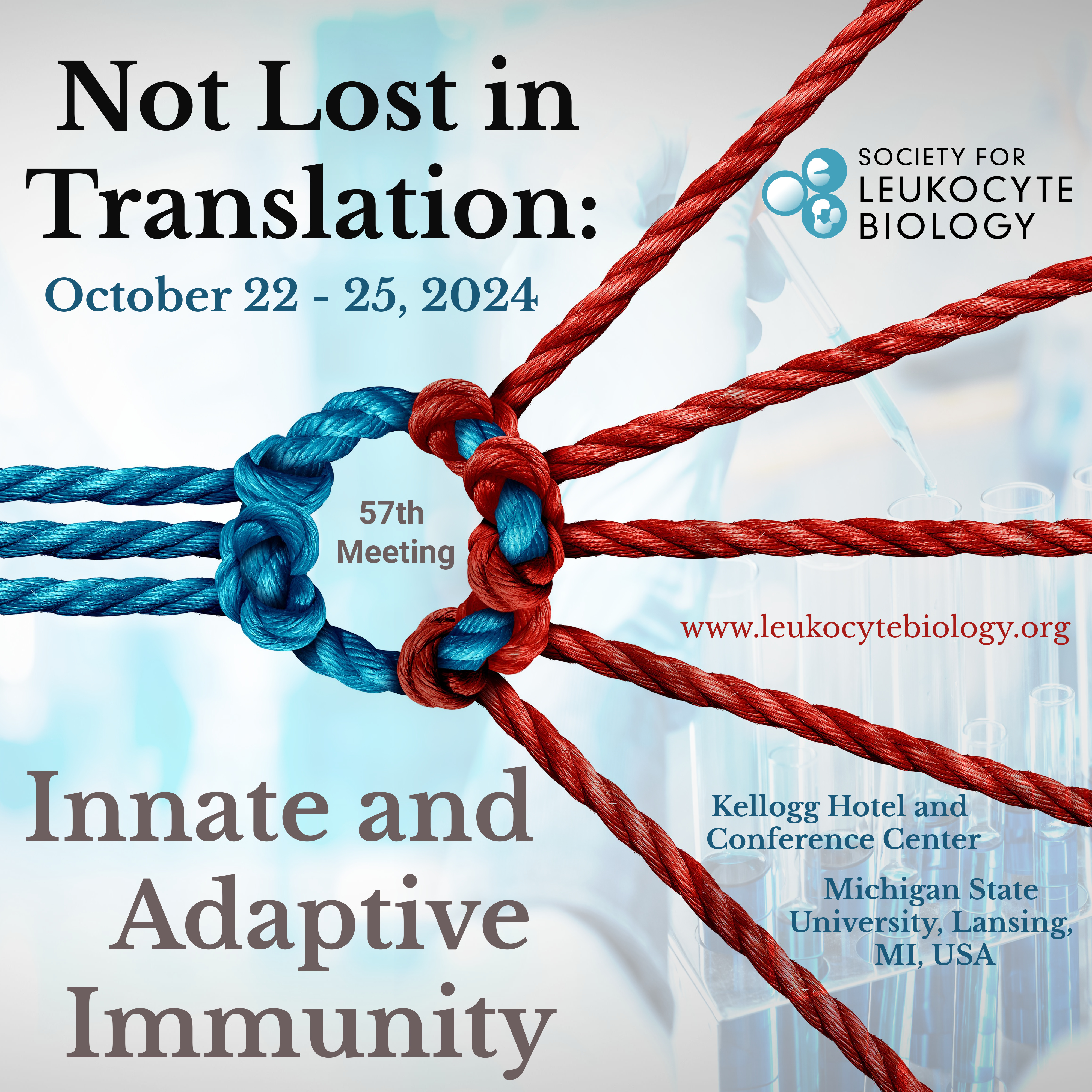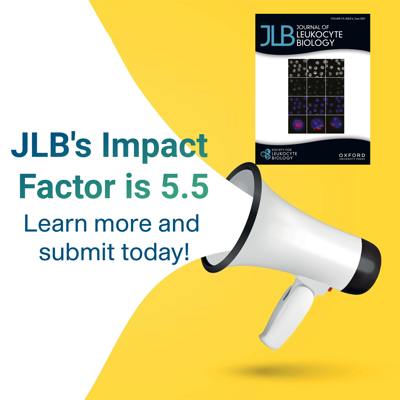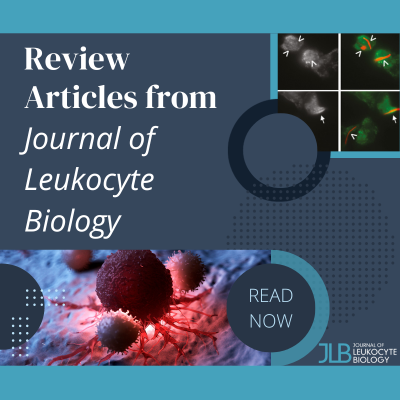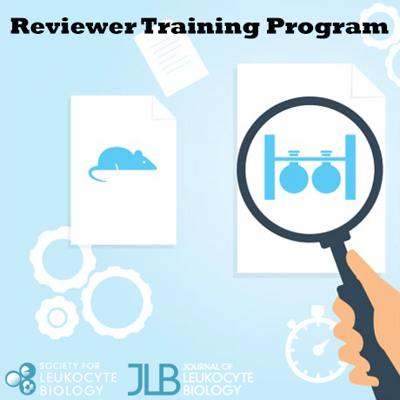| JLB Vol 110 no 1 eTOC |
ISSUE INFORMATION Issue InformationPages: 1-5 | First Published: 29 June 2021 EDITORIAL As a matter of fat: Leptin, monocyte hyperactivation, and COVID‐19: A commentary to “Leptin correlates with monocytes activation and severe condition in COVID‐19 patients” Antonio Recchiuti
Pages: 7-8 | First Published: 13 April 2021 SPOTLIGHT ON LEADING EDGE RESEARCH Leptin correlates with monocytes activation and severe condition in COVID‐19 patients Jingya Wang, Yinyin Xu, Xiaoli Zhang, Sheng Wang, Ziyi Peng, Jing Guo, Hongmei Jiang, Jing Liu, Ying Xie, Jingjing Wang, Xin Li, Juan Liao, Chao Wan, Lihua Yu, Jinsong Hu, Beizhong Liu, Zhiqiang Liu
Pages: 9-20 | First Published: 06 January 2021 Genome‐wide DNA methylation profiling of peripheral blood reveals an epigenetic signature associated with severe COVID‐19 Michael J. Corley PhD, Alina P.S. Pang PhD, Kush Dody, Philip A. Mudd MD, Bruce K. Patterson MD, Harish Seethamraju MD, Yaron Bram PhD, Michael J. Peluso MD, Leonel Torres, Nikita S. Iyer, Thomas A. Premeaux PhD, Stephen T. Yeung PhD, Vasuretha Chandar, Alain Borczuk MD, Robert E. Schwartz MD, PhD, Timothy J. Henrich MD, Steven G. Deeks MD, Jonah B. Sacha PhD, Lishomwa C. Ndhlovu MD, PhD
Pages: 21-26 | First Published: 19 January 2021 REVIEWS Effects of mesenchymal stromal cell‐derived extracellular vesicles in acute respiratory distress syndrome (ARDS): Current understanding and future perspectives Yue Su, Haiyan Guo, Qinghua Liu
Pages: 27-38 | First Published: 06 May 2021 PRIMARY RESEARCH IL‐26 promotes the pathogenesis of malignant pleural effusion by enhancing CD4+IL‐22+ T‐cell differentiation and inhibiting CD8+ T‐cell cytotoxicity Yiran Niu, Linlin Ye, Wenbei Peng, Zihao Wang, Xiaoshan Wei, Xu Wang, Yu Li, Siyu Zhang, Xuan Xiang, Qiong Zhou
Pages: 39-52 | First Published: 13 April 2021 Serum sphingolipid profile in asthma Chenglin Guo, Lina Sun, Linlin Zhang, Fawu Dong, Xu Zhang, Liu Yao, Chun Chang
Pages: 53-59 | First Published: 18 February 2021  Graphical Abstract Liquid chromatography-mass spectrometry-based targeted metabolomic profiling was performed on serum samples from both patients with asthma and control subjects. Sphingomyelin (SM) levels were significantly decreased in the asthma patients compared to the healthy controls. SM levels were also decreased in the blood noneosinophilic asthma group compared with the blood eosinophilic asthma group and in the early-onset group compared with the late-onset group. SM may be involved in the pathogenesis of asthma and related to different inflammatory cell subtypes. SM is thought to be a protective factor in asthma. REVIEWS Hypoxia‐inducible factors not only regulate but also are myeloid‐cell treatment targets Lovis Kling, Adrian Schreiber, Kai-Uwe Eckardt, Ralph Kettritz
Pages: 61-75 | First Published: 18 October 2020 The functions of EZH2 in immune cells: Principles for novel immunotherapies Fang-Fei Shao, Bo-Jin Chen, Guo-Qing Wu
Pages: 77-87 | First Published: 11 October 2020 Functional consequences of a close encounter between microglia and brain‐infiltrating monocytes during CNS pathology and repair Alessandra Quarta, Zwi Berneman, Peter Ponsaerts
Pages: 89-106 | First Published: 06 November 2020 Alveolar and lung interstitial macrophages: Definitions, functions, and roles in lung fibrosis Ting Shi, Laura Denney, Huazhang An, Ling-Pei Ho, Yuejuan Zheng
Pages: 107-114 | First Published: 06 November 2020 From virus to inflammation, how influenza promotes lung damage Mitchell Klomp, Sumit Ghosh, Sohail Mohammed, M. Nadeem Khan
Pages: 115-122 | First Published: 08 September 2020 RESEARCH Surface translocator protein 18 kDa (TSPO) localization on immune cells upon stimulation with LPS and in ART‐treated HIV+ subjects Lance K. Blevins, Robert B. Crawford, Diana J. Azzam, Tomás R. Guilarte, Norbert E. Kaminski
Pages: 123-140 | First Published: 17 November 2020 P2Y12 antagonism results in altered interactions between platelets and regulatory T cells during sepsis Samara Albayati, Harika Vemulapalli, Alexander Y. Tsygankov, Elisabetta Liverani
Pages: 141-153 | First Published: 26 November 2020 HOST DEFENSE AND PATHOPHYSIOLOGY Effects of serum amyloid protein A on influenza A virus replication and viral interactions with neutrophils Mitchell R. White, I-Ni Hsieh, Xavier De Luna, Kevan L. Hartshorn
Pages: 155-166 | First Published: 17 November 2020 Mycobacterium leprae induces a tolerogenic profile in monocyte‐derived dendritic cells via TLR2 induction of IDO Jéssica A. P. Oliveira, Mariana Gandini, Jorgenilce S. Sales, Sérgio K. Fujimori, Mayara G. M. Barbosa, Valber S. Frutuoso, Milton O. Moraes, Euzenir N. Sarno, Maria C. V. Pessolani, Roberta O. Pinheiro
Pages: 167-176 | First Published: 11 October 2020 Monocytic myeloid‐derived suppressor cells reflect tuberculosis severity and are influenced by cyclooxygenase‐2 inhibitors Marthe Jøntvedt Jørgensen, Synne Jenum, Kristian Tonby, Rasmus Mortensen, Gerhard Walzl, Nelita Du Plessis, Anne Ma Dyrhol-Riise
Pages: 177-186 | First Published: 06 November 2020 Tissue‐specific murine neutrophil activation states in health and inflammation Jeffrey W. Chadwick, Noah Fine, William Khoury, Nikola Tasevski, Chun-Xiang Sun, Parastoo Boroumand, Amira Klip, Michael Glogauer
Pages: 187-195 | First Published: 04 November 2020 SYSTEM BIOLOGY AND IMMUNOGENETICS MDS‐associated SF3B1 mutations enhance proinflammatory gene expression in patient blast cells Daniel A. Pollyea, Hyun Min Kim, Brett M. Stevens, Frank Fang-Yao Lee, Chelsea Harris, Brenna R. Hedin, Jennifer R. Knapp, Brian P. O'Connor, Craig T. Jordan, Eric M. Pietras, Aik Choon Tan, Scott Alper
Pages: 197-205 | First Published: 06 November 2020 |
























